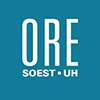To subscribe to the ORE seminar mailing list, click here.
For a (working draft) list of upcoming seminars, click here.
If you are interested in giving an ORE seminar, please contact us at nosal [at] hawaii [dot] edu.

- This event has passed.
Seminar: Wind-tracing Floating Offshore Structures
3 November 2021 @ 9:00 am - 10:00 am
Dr. Masoud Hayatdavoodi
Associate Professor in Marine Hydrodynamics and Ocean Engineering
School of Science and Engineering
University of Dundee
Dundee, Scotland, UK
Offshore wind is a promising source of marine renewable energy, and one of the fastest-emerging energy alternatives. The UK and many other countries have invested heavily on wind energy, and it is expected that wind, along with solar, would be the two dominant forms of renewable energy soon. Main advantages of the offshore wind resources over near shore options include (i) access to more consistent and powerful wind, (ii) flexibility in site selections, (iii) elimination of visual impacts, (iv) versatile hull designs for use in different locations, and (v) relatively easier installation process. While there are significant advantages of approaching offshore wind, the cost of construction, installation, operation and maintenance, and hence energy production, is relatively high in offshore wind sector. For offshore wind to become competitive, it is highly desirable to introduce cost-effective technologies and solutions.
Most of the existing floating offshore wind turbines (FOWT hereafter), whether in concept or commercial projects, host a single turbine. Recently, structures that host multiple turbines have received attention, mainly to reduce the overall cost of energy production. The main concept challenge of placing multiple wind turbines on a single platform is that under variable wind directions, the leading turbines block the wind. Wind-tracing offshore structures, where the structure rotates in response to the environmental loads, are being considered by the industry as an alternative solution for hosting multiple turbines.
Analysis and design of such structures, however, goes beyond the state-of-the-art. Some of the specific challenges in analysing these systems include determinations of (i) the dynamic response of the floating structure to simultaneous hydrodynamic (waves, current and moorings) and aerodynamic (wind) loads, (ii) the elastic response of the structure due to its very large dimensions (comparable to very large floating structures), and (iii) the efficiency of the system due to the wake effect on neighbouring turbines. In a series of internationally joint projects, my group and I are investigating these concepts.
In this seminar, an overview will be provided on the status of marine renewable energy sector in the UK and globally. This will be followed by introduction of wind-tracing floating offshore structures, and discussion about recent laboratory experiments and computational models developed to study waves, current and wind interaction with such structures.
Zoom Meeting Link:
Meeting ID: 935 9608 7383
Passcode: OREseminar
https://hawaii.zoom.us/j/93596087383
